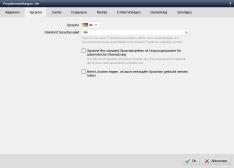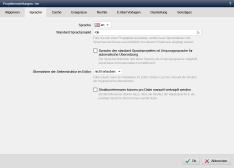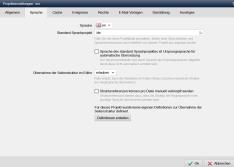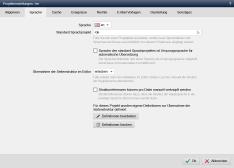Content project - Project settings (language)
You can make various language settings in the project settings for the content project or language project.

Click on the"Project settings" button to open a new window with the settings for the content project.




Operation
'Language':
You can use this selection box to optionally select the language abbreviation with associated flag that is to be assigned to the content project. The selection is only required for content projects that are to be managed via the additional module Language management and the language selection in the presence.
'Default language project':
In this field, you optionally select the directory that is to be used as the default language project. New language files and language directories may only be created via the project specified here (recommended for multilingual projects and use of the Extended language management module, see also developer article).
'Language of default language project is original language for automatic translation':
If this parameter is activated, the language interface is informed of this language as the source language so that it does not have to be determined automatically.
'When deleting, ask whether linked languages should also be deleted':
If this parameter is activated, when a file is deleted within the standard language project, the system asks whether the linked language pages should also be deleted.
When a file is deleted, the corresponding selection is made via the "Confirm deletion" screen:
- Yes
Deletes only the file clicked for deletion - Yes, including linked languages
Deletes both the file clicked for deletion and the language files linked to it - No
Cancels the deletion process.
This option is only available in the standard language project.
'Adopt page structure in editor':
You can use this selection box to specify whether the structure of the reference language (main language) can be adopted in this language (e.g. en) depending on the setting in the project.
This setting is only available in languages that refer to another language project (main language) via the"Default language project" field.
The following selection options are available for this:
- do not allow
The page structure cannot be adopted. - allow
The page structure can be adopted from the main language by clicking on the status tab. - Allow if a structure reference already exists
The page structure can be adopted from the main language by clicking on the status tab if a structure reference already exists. - Allow and structure editor deactivated by structure reference
The page structure can be adopted from the main language by clicking on the status tab. The structure editor is deactivated in the relevant language.
A structure reference is used to specify the structure via the main language and thus makes fully automatic translation possible in the first place. Individual pages, which are maintained individually, do not require a structure reference.
'Structure references can be linked manually per file':
If this parameter is activated, the structure references can be linked manually per file.
Within the file explorer, the selection "Create structure reference" or "Delete structure reference" then also appears in the context menu for a file.
This setting only appears if it is permitted to adopt structure references.
'Definitions for adopting the page structure':
By clicking on the "Create definitions" button, you can optionally create a page structure definition for the language based on the system definitions.
There you can define specifically via xpath specification which text areas are to be recorded.
'Further notes':
The target language can be manually defined differently in the wProject.php of the language project. This can be useful, for example, if you have various English-language country pages that are to be translated into British English.
/wProject/language/@deeplTargetLang
For country codes see: deepL-API (Translating text)


